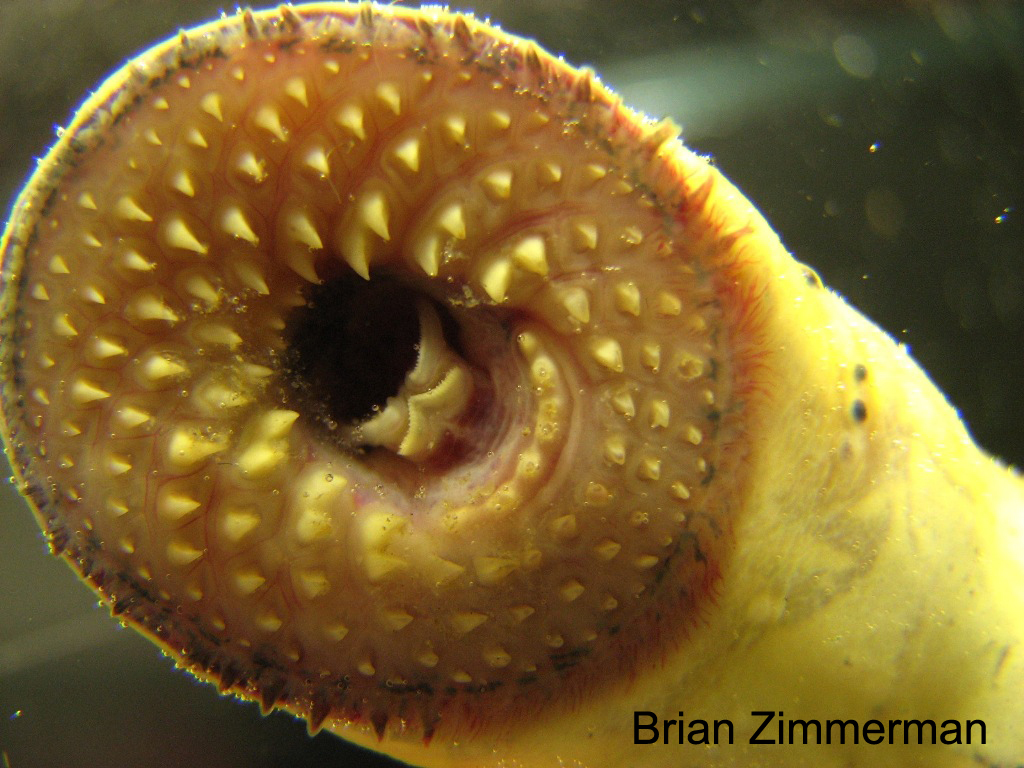Ohio Lamprey
(Ichthyomyzon bdellium)


The Ohio lamprey is one of seven lamprey species found in Ohio. This species is one of the two native parasitic species but they rarely if ever actually kill their host fish. Six of the seven species of lampreys are native to Ohio and pose no threat to sport fish. Only the sea lamprey is not native and a potential threat.
Description
All lampreys have a long eel-like body and no scales. They have segments of muscles that are visible along their body called myomeres, and a jawless mouth. In larval lampreys, called ammocoetes, their mouth is not fully developed, very small, and hidden between folds of skin. Adults have a disk shaped mouth with varying amounts of teeth depending on the species. The Ohio lamprey has a single continuous dorsal fin, not separated into two distinct parts. This species is parasitic on larger fish as adults. They have 53-62 myomeres (muscle segments) between the last gill opening and the anus. The disc like mouth (lower photo) of the adults contains bicuspid or two pointed teeth around the mouth. Teeth on the outer portion of the disc are well developed and not difficult to see. Adults are a light tan or silvery tan in coloration prior to spawning. During spawning, adults become blue-black in color. The Ohio lamprey differs from the moutain brook lamprey by having well developed teeth on the outer portion of the disc like mouth, reaching a larger size, and being parasitic as adults. Nothern brook and silver lampreys have only single pointed teeth around the opening of the mouth. All other Ohio lamprey species have 2 separate dorsal fins.
Habitat and Habits
All parasitic lampreys required three distinctly different habitats that are connected by free flowing (free of dams) stretches of streams. Spawning adults are found in clear brooks with fast flowing water and either sand or gravel bottoms. Juveniles or ammoccoetes are found in slow moving water buried in soft substrate of medium to large streams. Non-spawning parasitic adults are found in large bodies of water (Lake Erie or the Ohio River) with abundant populations of large fish. Ohio lampreys are only found in the Ohio River and the lower portion of its tributary streams.
Reproduction and Care of the Young
Ohio lampreys spawn in late May or early June in shallow pits that are excavated near the upper ends of gravel riffles. These pits are created communally by several individuals constructing one pit. They use their suction cup like mouth to move stones away to form the pit. Females then deposit many eggs in these pits. After hatching, the ammocoetes (larval stage of lampreys) drift down stream to larger slower moving streams and burrow into the sediment. During this phase, they eat organic particles strained from bottom sediments and the water, as well as microscopic organisms. After several years, the ammocoetes transform into a parasitic adult in spring. Adults migrate into the Ohio River and feed on other fish. The following spring they migrate into tributary streams spawn and then die shortly after.